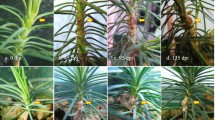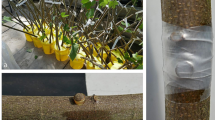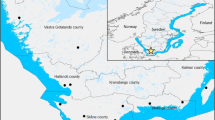Abstract
Artificially introduced zoospores of Phytophthora cinnamomi were shown to invade non-wounded and deliberately wounded periderm at the lower stem and collar of one-year-old seedlings of Eucalyptus marginata (jarrah) growing in a rehabilitated bauxite mine, during late autumn/early winter. Lesions were not produced in the majority of seedlings despite the demonstrated presence of the pathogen in the symptomless stem tissue.
Similar content being viewed by others
References
Byrt, P. and Grant, B.R. (1979) — Some conditions governing zoospore production in axenic cultures of Phytophthora cinnamomi Rands. Australian Journal of Botany 27: 103–115.
Cahill, D., Legge, N., Grant, B. and Weste, G. (1989) — Cellular and histological changes induced by Phytophthora cinnamomi in a group of plant species ranging from fully susceptible to fully resistant. Phytopathology 79: 417–424.
Colquhoun, I.J. and Petersen, A.E. (1994) — The impact of plant disease on mining. Plant Diseases in Ecosystems: Threats and impacts in south-western Australia. Journal of the Royal Society of Western Australia 77: 151–158.
Davison, E.M., Stukely, M.J.C., Crane, C.E. and Tay, F.C.S. (1994) — Invasion of phloem and xylem of woody stems and roots of Eucalyptus marginata and Pinus radiata by Phytophthora cinnamomi. Phytopathology 84: 335–340.
Dell, B. and Malajczuk, N. (1989) — Jarrah dieback, a disease caused by Phytophthora cinnamomi. In The Jarrah Forest (Eds B. Dell, J.J. Havel and N. Malajczuk), pp. 67–87. Kluwer Academic Publishers, Dordrecht, The Netherlands.
Dell, B. and Wallace, I.M. (1981) — Recovery of Phytophthora cinnamomi from naturally infected jarrah roots. Australasian Plant Pathology 10: 1–3.
Dickinson, C.H. and Lucas, J.A. (1982) — Plant Pathology and Plant Pathogens. 2nd Edition. Blackwell Scientific Publications.
Halsall, D.M. and Williams, J.D. (1984) — Effect of root temperature on the development of Phytophthora cinnamomi root rot in Eucalyptus seedlings. Australian Journal of Botany 32: 521–528.
Hardham, A.R., Gubler, F., Duniec, J. and Elliott, J. (1991) — A review of methods for the production and use of monoclonal antibodies to study zoosporic plant pathogens. Joumal of Microscopy 162: 305–318.
Hardy, G.E.St.J., Colquhoun, I.J. and Nielsen, P. (1996) — The early development of Phytophthora cinnamomi in Eucalyptus marginata and Eucalyptus calophylla growing in rehabilitated mines. Plant Pathology 45: 944–954.
Hinch, J.M., Wetherbee, R., Mallett, J.E. and Clarke, A.E. (1985) — Response of Zea mays roots to infection with Phytophthora cinnamomi. 1. The epidermal layer. Protoplasma 126: 178–187.
Jeffers, S.N. and Martin, S.B. (1986) — Comparison of two media selective for Phytophthora and Pythium species. Plant Disease 70: 1038–1043.
Marks, G.C., Smith, I.W. and Kassaby, F.Y. (1981) — Trunk infection of Eucalyptus species by Phytophthora cinnamomi Rands: A preliminary report. Australian Forest Research 11: 257–267.
O’Gara, E., Hardy, G.E.St.J. and McComb, J.A. (1996) — The ability of Phytophthora cinnamomi to infect through unwounded and wounded periderm tissue of Eucalyptus marginata. Plant Pathology 45: 955–963.
Shea, S.R., Shearer, B.L. and Tippett, J.T. (1982) — Recovery of Phytophthora cinnamomi Rands from vertical roots of jarrah (Eucalyptus marginata Sm). Australasian Plant Pathology 11: 25–28.
Shea, S.R., Shearer, B.L., Tippett, J.T. and Deegan, P.M. (1984) — A new perspective on jarrah dieback. Forest Focus 31: 3–11.
Shearer, B.L., Shea, S.R. and Deegan, P.M. (1987) — Temperature-growth relationships of Phytophthora cinnamomi in the secondary phloem of roots of Banksia grandis and Eucalyptus marginata. Phytopathology 77: 661–665.
Shearer, B.L., Shea, S.R. and Fairman, R.G. (1981) — Infection of the stem and large roots of Eucalyptus marginata by Phytophthora cinnamomi. Australasian Plant Pathology 10: 2–3.
Shearer, B. and Tippett, J. (1989) — Jarrah Dieback: The dynamics and management of Phytophthora cinnamomi in the jarrah (Eucalyptusmarginata) forest of south-western Australia. Research Bulletin No. 3. Western Australian Department of Conservation and Land Management.
Stoneman, G.L., Dell, B. and Turner, N.C. (1995) — Growth of Eucalyptus marginata (jarrah) seedlings in mediterranean-climate forest in south-west Australia in response to overstorey, site and fertiliser application. Forest Ecology and Management 79: 173–184.
Tippett, J.T., Hill, T.C. and Shearer, B.L. (1985) — Resistance of Eucalyptus spp. to invasion by Phytophthora cinnamomi. Australian Journal of Botany 33: 409–418.
Tippett, J.T., Holland, A.A., Marks, G.C. and O’Brien, T.P. (1976) — Penetration of Phytophthora cinnamomi into disease tolerant and susceptible eucalypts. Archives of Microbiology 108: 231–242.
Tippett, J.T., Shea, S.R., Hill, T.C. and Shearer, B.L. (1983) — Development of lesions caused by Phytophthora cinnamomi in the secondary phloem of Eucalyptus marginata. Australian Journal of Botany 31: 197–210.
Ward, S.C., Koch, J.M. and Ainsworth, G.L. (1996) — The effect of timing of rehabilitation procedures on the establishment of a jarrah forest after bauxite mining. Restoration Ecology 4: 19–24.
Zentmyer, G.A. (1980) — Phytophthora cinnamomi and the diseases it causes. Monograph 10. The American Phytopathological Society, St. Paul.
Author information
Authors and Affiliations
Rights and permissions
About this article
Cite this article
O’Gara, E., McComb, J.A., Colquhoun, I.L. et al. The infection of non-wounded and wounded periderm tissue at the lower stem of Eucalyptus marginata by zoospores of Phytophthora cinnamomi, in a rehabilitated bauxite mine. Australasian Plant Pathology 26, 135–141 (1997). https://doi.org/10.1071/AP97023
Received:
Accepted:
Issue Date:
DOI: https://doi.org/10.1071/AP97023




